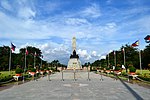Plaza Dilao
Plaza Dilao | |
|---|---|
| Public square | |
Dom Justo Takayama, who settled here after he was exiled from Japan in 1615. | |
| Owner | City of Manila |
| Location | Quirino Avenue, Paco Manila, Philippines |
| Coordinates: 14°34′51″N 120°59′58″E / 14.58083°N 120.99944°E | |
Plaza Dilao is a
Dom Justo Takayama, who settled there in 1615.[2] It is one of two open public spaces in Paco, the other being Paco Park
.
Currently, Plaza Dilao is one of five freedom parks in the City of Manila, where protests and rallies may be held without requiring permission from local authorities.[3]
History
In
Dom Justo Takayama and his family settling in the surrounding area after they were exiled from Japan in 1615,[2] most Japanese in Manila at the time were settled around the area now occupied by the Philippine Normal University.[1] However, in 1762, the Japanese residents of Manila were later relocated here by the Spanish authorities, although after then the community's population began to decline owing to reduced Japanese immigration to the Philippines and Japan's policy of sakoku.[4] It is believed that the presence of the Japanese community around the plaza eventually led it to being called "Plaza Dilao",[5] referring to the yellowish (dilaw in Tagalog
) skin tone of the area's inhabitants.
During the
Cleto Rodriguez.[6] The plaza is still considered a transport center today: when former President Joseph Estrada became Mayor of Manila in 2013, he ordered a ban on city buses entering Manila, with buses for a while terminating at the plaza instead of their usual terminus at the Liwasang Bonifacio.[7]
Surrounding buildings and structures
Aside from the Paco railway station, two prominent organizations in the Philippines are headquartered in the immediate vicinity of Plaza Dilao. The Philippine Columbian Association (PCA), the Philippines' oldest sporting club, relocated its headquarters to the plaza on April 1, 1979,Skyway Stage 3's Plaza Dilao Exit is being currently being constructed around the plaza, particularly along Plaza Dilao Road.
References
- ^ a b c Liao, Shubert S.C., ed. (1964). Chinese Participation in Philippine Culture and Economy. Manila: Bookman. p. 155.
- ^ ISBN 978-971-506-390-6.
- GMA News and Public Affairs. May 2, 2006. Retrieved January 23, 2014.
- Zaide, Gregorio F. (1957). The Philippines Since Pre-Spanish Times. Vol. 2. Manila: Philippine Education Company. p. 293.
- ^ Gamil, Jaymee T. (March 17, 2012). "A samurai lives on in Paco". Philippine Daily Inquirer. Philippine Daily Inquirer, Inc. Retrieved January 23, 2014.
- ISBN 978-1-59884-427-6.
- ^ Valdoz, Harmony (August 11, 2013). "Manila bus ban: Of guinea pig commuters and ulterior motives". The Muralla. Manila Times Publishing Corporation. Retrieved January 23, 2014.
- ISBN 9719342315.
- ^ "TODAY IN HISTORY: In 1913, the Association de Damas Filipinas was established". TV5 News and Information. September 26, 2011. Retrieved January 23, 2014.
Wikimedia Commons has media related to Plaza Dilao.

